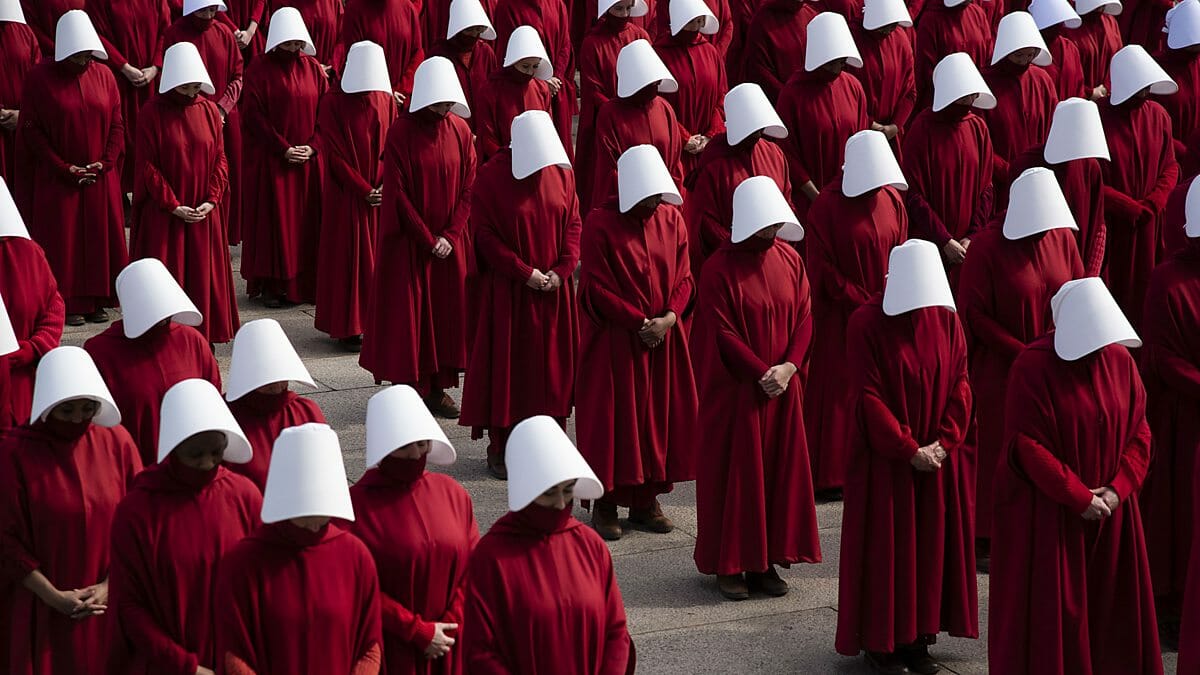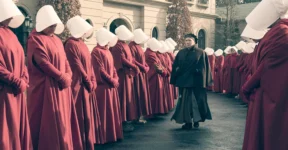Many novel-based TV series are faithful to the source materials, while others are not so much – although this does not mean the screen adaptations are worse or better than the original. Hulu’s The Handmaid’s Tale series is one of the few shows in which the storyline and characters are depicted almost entirely with what’s been written in the book based on which it is produced.

Both the novel and the series tell a story of a dystopian society where the birthrate has declined to a worrying degree because of pollution and ravaging STDs. Women are second-class citizens with very limited roles; many of them are slaves to the ruling elites. Among those slaves are handmaids, fertile women who are subjected to ritual rape to be impregnated by their male masters in the presence of their wives. Handmaids must bear at least one child for their owners, otherwise, they are as good as gone.
Be that as it may, there are noticeable differences between the screen adaptation and the source material. Some of the most noticeable are as follows.
- Offred’s Identity
Let us start with the name of the main character, Offred. Each time a handmaid moves to a new master, she is not allowed to use her real name. Instead, she must take the first name of her master and add the prefix “Of” as her new identity. Offred means Fred’s handmaid. The novel never mentions Offred’s real name. The series reveals she is actually June at the end of the first episode.
- Feisty Offred
Margaret Atwood’s novel introduces the reader to Offred, the main character, as a somewhat passive woman. She only wants to survive the totalitarian society, not rebel against the system. In the screen adaptation, Offred is much more indignant at the unfair situation although she does a good job at keeping the anger inside. She is obedient at first glance, but there is a burning desire inside to break free.
The anger is well-displayed in the first episode when handmaids may punish a man accused of raping a pregnant handmaid and killing her baby. Once again, the novel depicts her as feeling disturbed by the violence and avoiding the scene. The series pictures Offred as one of the first handmaids to attack a man with no sign of moral conflict.
- Diverse Gilead
The totalitarian regime in Gilead, where the story takes place, is ruled by white men. In the novel, people of color have their own place in society and are resettled in their National Homelands. There is no explanation of whether the non-whites are enslaved or killed. The screen adaptation features more people of color.
LGBTQ people are also scarce in the novel. June’s best friend, Moira, is openly gay but there is a bit of confusion on how June must react and adapt to such sexuality. In the series, June has no problem with it. Ofglen was also once married to a woman before her time in Gilead.
According to show creator Bruce Miller, the change is necessary because there is a big difference between a TV series about racist people and a racist TV series. People are unlikely to have any qualms reading a story in which everyone is white, but such a scene on screen might come across as inappropriate.
- Supporting Characters’ Backgrounds
Because the novel’s narration is told only from Offred’s perspective, it doesn’t give a lot of room to explore the backgrounds of some supporting characters. For example, Aunt Lydia never strays too far from her basic description as an uncompromising enforcer of the rules of handmaids’ conduct.

Although the book never really sees the character beyond Offred’s viewpoint, the TV series can easily stretch the storytelling angle to give a more insightful look into Aunt Lydia’s backstory. It doesn’t happen to all the supporting characters, but at least the series can shine some light on the plot-relevant figures, making it easier for viewers to understand Gilead as a whole.
- Modernization
Margaret Atwood’s The Handmaid’s Tale book was first published in 1985, and the dystopian society depicted in the novel is set in a hypothetical near-future. Nothing is changed in that regard, but it requires some adjustments to make the story relevant to the present timeline. The TV series premiered in 2017, so it needs to give a different take on the “near future” idea. In the series, viewers can probably spot references to modern conveniences such as smartphones and Uber. Even the sterilization tattoos on the handmaids are changed to advanced tracking tags.
The Handmaid’s Tale series and the novel have their differences in many respects, and yet it is different to say with any certainty that one is better than the other. Each version has weak points. For instance, the limitation of the storytelling perspective in the book offers more suspense and mystery of the unknown; as for the series, viewers get to see a broader view of every major event.
It is a good thing that Margaret Atwood herself is involved in the series production as a consulting producer to keep the story faithful to the source material and expand the narration without unnecessary deviation.
Have you read The Handmaid’s Tale and watched the show, too? Which one you enjoy the most? We’d love to hear from you.
Other things you might want to know
Who are the major cast and characters in the show?
- Elisabeth Moss as June Osborne/ Offred/Ofjoseph #2
- Joseph Fiennes as Fred Waterford
- Yvonne Strahovski as Serena Joy Waterford
- Alexis Bledel as Dr Emily Malek/Ofglen #1/Ofsteven/Ofroy/Ofjoseph #1
- Madeline Brewer as Janine Lindo/Ofwarren/Ofdaniel/Ofhoward/Ofjoseph #3
- Ann Dowd as Aunt Lydia Clements
- O-T Fagbenle as Luke Bankole
- Max Minghella as Nick Blaine
- Samira Wiley as Moira Strand
- Amanda Brugel as Rita Blue
- Bradley Whitford as Joseph Lawrence
- Sam Jaeger as Mark Tuello
Most popular books by Margaret Atwood:
- Bodily Harm (1981)
- Life Before Man (1979)
- Surfacing (1972)
- The Edible Woman (1969)
- Lady Oracle (1976)
- The Robber Bride (1993)
- Hag-Seed (2016)
- Cat’s Eye (1988)
- The Heart Goes Last (2015)
- MaddAddam (2013)
- Oryx and Crake (2003)
- The Penelopiad (2005)
- Alias Grace (1996)
- The Blind Assassin (2000)
- The Year of the Flood (2009)
- The Handmaid’s Tale (1985)
Books by Margaret Atwood that have been adapted to films or TV series?
Films:
- Payback (2012)
- In the Wake of the Flood (2010)
- The Robber Bride (2007)
- The Handmaid’s Tale (1990)
- Heaven On Earth (1987)
- Surfacing (1981)
TV Series:
- Alias Grace (2017)
- The Handmaid’s Tale (2017)
Check out other articles by month:







